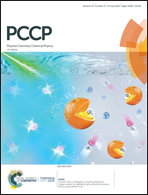Room temperature ferromagnetic properties of In2S3 nanoparticles regulated by doping with Gd ions†
Abstract
In2S3, having a suitable bandgap and tunable magnetism, is a promising material for spintronic applications. Herein, we report that pristine In2S3 and In2S3:Gd3+ nanoparticles, with room temperature ferromagnetism, were synthesized by a gas–liquid phase chemical deposition method. The bandgap value, photoluminescence (PL) intensity and magnetic properties of In2S3:Gd3+ nanoparticles can be tuned by regulating the Gd3+ dopant concentration. In addition, the measured saturation magnetization in undoped In2S3 nanoparticles is 0.011 emu g−1 and the maximum saturation magnetization observed in In2S3:Gd3+ nanoparticles is 0.035 emu g−1; the corresponding magnetic mechanism is explicated based on bound-magnetic-polaron (BMP) theory. First-principles DFT calculations reveal that In vacancy and Gd3+ ion doping can induce intrinsic ferromagnetism. Finally, the results obtained from experiment and theory suggest the potential of Gd-doped In2S3 for application in spintronic devices.



 Please wait while we load your content...
Please wait while we load your content...